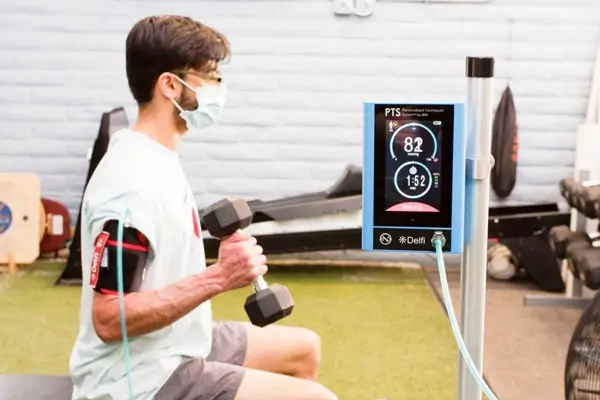 By Seth Egge, PT, Clinic Director of PRN Physical Rehabilitation – La Mesa
By Seth Egge, PT, Clinic Director of PRN Physical Rehabilitation – La Mesa
Imagine… You’re in your mid-30s, you have a two-year-old child and just found out you are expecting twins. You are working from home and doing the best you can to keep it together while amid a pandemic. The next morning, you start to feel fatigued and chalk it up to having a busy day. Later that evening, you develop a fever and start to have difficulty breathing.
 Seth Egge, PT
Seth Egge, PT
You go to the doctor for an assessment and are informed you have COVID-19 and will need to stay in the hospital as you have an oxygen saturation level of below 85 percent and a resting heart rate of 110 that will not decrease. As you are placed on supplemental oxygen, you realize that your worst fears have come to light.
The next nine days spent in the hospital are some of the most frightening. The very thought of getting out of bed makes you breathless. Your legs are so weak, you cannot walk without a walker – of which you have only ever associated with your 80-year-old grandparent. Your heart races as you attempt to walk from the bed to the bathroom and it feels as if you just ran a 400-yard dash.
You finally turn the corner, and your vitals stabilize. The doctor discharges you from the hospital with a spirometer, walker, and prescriptions for your multitude of continued symptoms. While you are excited to go home, you’re also concerned about bouncing back to your normal routine. A check-in with your primary care doctor leads you to physical therapy – which you quickly realize is the best thing to help you regain your strength and get back to normal.
How the PACER Program can help those recovering from COVID-19
The above story is just one of many that I have heard over the past year as a physical therapist.
Thankfully, I, along with other trained physical therapists, am prepared to help those recovering from severe cases of COVID-19 who are left with lingering symptoms that impact day-to-day tasks and routines. The PACER Program, or the Post-Acute COVID-19 Exercise and Rehabilitation program, was developed to specifically help individuals who have recovered from COVID-19 regain their normal lives.
Over the past few months, I have encountered multiple PACER patients who needed physical therapy services. While each clinical case is unique, each of the patients I treated had a few things in common:
- Difficulty breathing
- Difficulty maintaining their O2 percent saturation
- An elevated resting heart rate
- Generalized muscle weakness
- Poor tolerance to daily activities
The above symptoms manifested due to COVID-19 and may prove to be life-altering without physical therapy treatment.
As physical therapists, we have adapted our practices so that we are now the providers of choice to assist individuals impacted by lasting effects from COVID-19. We have taken on the role of helping these individuals as they navigate living with long-term effects and strive to provide resources to help these individuals return to their pre-COVID state of function.
The PACER Program Treatment Experience
When working with PACER Program individuals, we conduct a variety of tests during their first appointment in order to get a baseline for their vitals and current abilities. During this initial visit, we test for the following:
- Timed up and go test
- Tinetti or Berg balance assessment
- Sit and stand five times
- Three-minute YMCA Step Test
- Six-minute walking test
- Inflate Balloon Test
These tests allow us to measure the individual’s growth throughout the course of the program. Normally, the full PACER Program lasts about eight weeks, but again, this varies from patient to patient depending on their specific symptoms.
In my experience, during the initial evaluation appointment, all patients were unable to complete the six-minute walk test and unsafe vital levels were reported. Not only that, but all individuals struggled to complete the test of sitting and standing five times and averaged less than one minute on the YMCA step test.
Over the course of the next eight weeks, I worked with a variety of these individuals during focused sessions of therapeutic exercise and activities to help them build up their stamina while working to regain their normal lives.
During these sessions, we often devote time for cardiovascular exercise, functional strength training and the remainder of the time we focus on breath training and meditation.
The PACER Program places an emphasis on patient education so that individuals are not only physically improving, but they are also understanding why. We help patients better control their breathing, implement interval exercise training principles and provide them with a progressive Home Exercises Programs (HEP) so that they can continue building up their strength and stamina at home.
Progress, not perfection
Recovering from an illness as impactful as COVID-19 is not always easy. As some individuals are severely impacted by the disease, the PACER Program timeline laid out above is not one size fits all. Over the past year, this program has been adapted to meet the needs of each individual patient.
It is important to remind patients that the goal of the PACER Program is to get them back to living their normal lives and that any progress forward is something to celebrate. Recovering from COVID-19 takes time, and as physical therapists, we are here to help ensure this recovery process is as targeted as possible.
If you or someone you know is having difficulties snapping back to their regular routine after having COVID-19 and are experiencing symptoms such as difficulty breathing, loss of strength or balance issues, we encourage you to reach out to your local PRN Physical Therapy clinic and ask about the PACER Program.